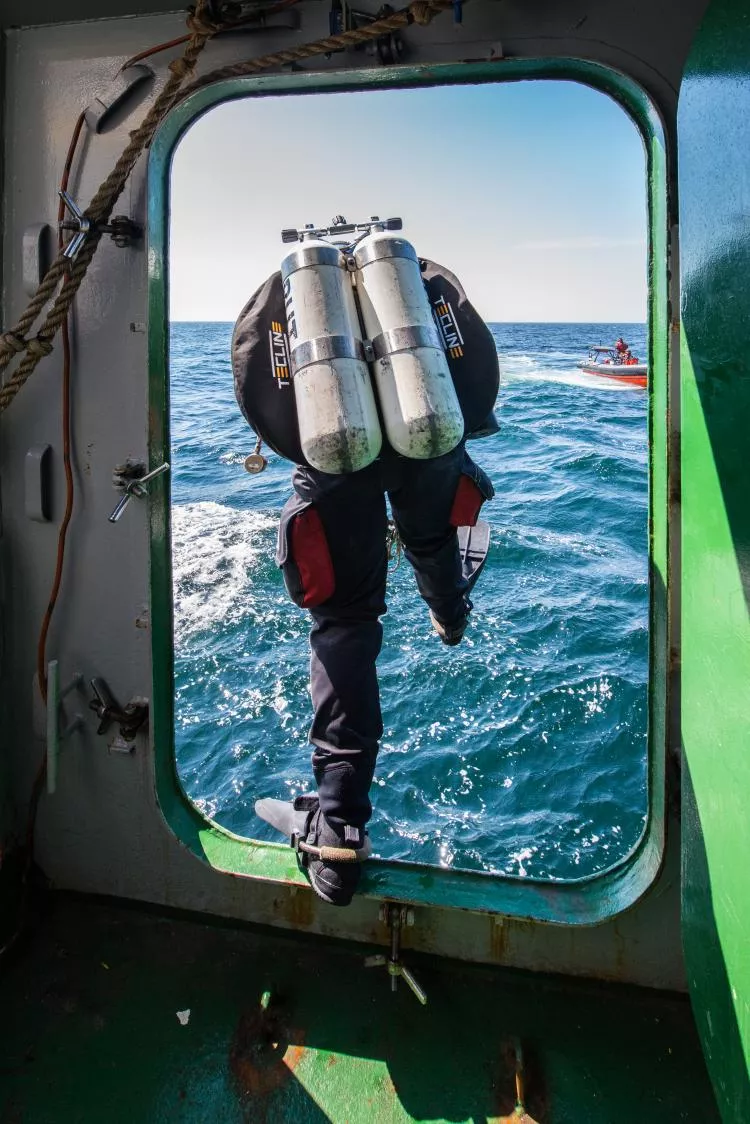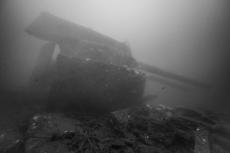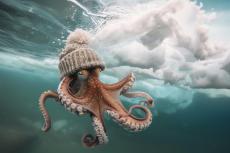In May 2016, the dive team of the Dutch Ghost Fishing Foundation helped a German Greenpeace campaign, with the goal of drawing attention to the sizable problem of ghost nets in the North Sea. After almost two weeks of ideal weather conditions—with bizarrely bad visibility underwater—the deck of the Arctic Sunrise boasted five enormous BIG BAGs (the Swedish eco-friendly garbage bag brand) full of nets and fishing lines. A considerable catch, but there is plenty more work waiting at the bottom of the German North Sea.
Contributed by
Factfile
From April 30 to May 10, the dive team of the Dutch Ghost Fishing Foundation was aboard the Arctic Sunrise.
The dive team included Pascal van Erp, Bas Poelmann, Hans van der Plas, Ben Oortwijn, Cees Kassenberg, Cas Renooij, Ron Baars, Rutger-Jan Hoogerdijk and Annet van Aarsen.
During those ten days of diving at the Sylter outer reef, the team made a total of 18 dives.
Only twice did they have a diving day with only a single dive—firstly, due to necessary compressor maintenance, and secondly, due to visiting German journalists, who came aboard to do media coverage.
REFERENCES:
¹ http://ec.europa.eu/environment/nature/natura2000/
“These wrecks have no ghost nets,” said Andi Peters, the man whose own website introduces him as “Der Nordseetaucher” (“The North Sea Diver”).
An experienced wreck diver, Peters can be found regularly on the Sylter outer reef in the German part of the North Sea, an area to the west of the island of Sylt and north of Helgoland.
Peters was on a ship in the distance when I first started helping the Dutch Ghost Fishing dive team on their Greenpeace campaign in early May, aboard the Arctic Sunrise. Greenpeace Germany wanted to see the protection of the Natura 2000 areas of the seas finally being put into action. [ed.– Stretching across 28 European countries, Natura 2000 is the world’s largest network of protected land and marine areas.¹]
“It is a very slow political process,” said Thilo Maack, campaign leader for Oceans of Greenpeace Germany. “In 2007, roughly a third of the German North Sea and the Baltic Sea have been designated Natura 2000 areas. But since then, practically nothing has happened. The protection is theoretical only.”
In a small part of the Sylter outer reef—one of those “unprotected” Natura 2000 areas—large boulders are a natural occurrence. It is somewhat like the Cleaver Bank in the Dutch part of the North Sea. In other places, the area has a sandy bottom. Despite its status as a “nature reserve”, there is a tremendous amount of fishing. Maack has a map of fishing activities that has been colored almost entirely black.
The goal of the expedition with Dutch Ghost Fishing dive team aboard was not the area with stones. We were going to dive for wrecks and hunt for ghost nets. An eye-opener for us: While we as ghost fishing volunteers mostly emphasize the fact that lost fishing equipment will keep on fishing at the bottom of the sea, causing many marine creatures to die a horrendous death, Greenpeace Germany also employs the argument that the nets are made of plastics. And plastics have no place in the sea. Not a bad idea at all, looking at the problem of ghost nets from that perspective. Even if the lost nets were to slowly degrade over the course of decades, does that mean the process would release all these micro-plastics into the sea water?
Finding wrecks
At least the weather was in our favor. When we set off from Cuxhaven on May 2, there was not a breath of wind, just a clear blue sky, some nice sunshine and waves less than a foot high. It was a pleasant way to start. After all, the Arctic Sunrise was nicknamed the “washing machine.” In choppier weather, Greenpeace’s rugged icebreaker is said to behave like a bucking horse. But now? The sea sickness tablets could stay at the bottom of the bag.
On the chart table was a list of wreck positions. We had no idea how accurate they were. “Are there really nets on every wreck?” the Greenpeace crew asked several times. “When we find a wreck, we find fishing gear,” replied Pascal van Erp—founder of the Dutch Ghost Fishing Foundation—very decisively.
After the first few dives, that first part—finding the wrecks—proved to be a difficult task. We threw out the wreck anchor several times, but when we dived down along the line to look for steel and nets, we found nothing but sand. On the bridge of the Arctic Sunrise, the sonar showed a result, but for some reason, the anchor was constantly thrown well away from wrecks.
After some experimentation, we quickly found a solution: The crew of the RIBs, who took to the water’s surface with every dive to assist the divers, could also see a wreck on their sonar. They then dragged the wreck anchor to the correct position. We never missed another wreck. And so, we found the MV Sorstrand, a small Norwegian cargo ship that went under in 1981. It was standing upright on the bottom.
Conflicting views
Dive after dive, we ran into something odd in this part of the German North Sea: The upper ten meters of water barely had any current, and visibility was good. Below that, the light was suddenly switched off, there were algae blooms everywhere, and the water looked like pea soup. Suddenly we found ourselves dangling in the current. The algae and current together created a “snowstorm” on the wreckage. Visibility was dreadful.
When Peters and his dive vessel cruised by, we called him over the marine telephone to politely ask him what he thought of the situation in regards to the tides. We never got a clear answer to the question about which tide tables he was using. We always saw him taking to the water a few hours after what we calculated ourselves. When asked if he knew any wrecks with a substantial amount of ghost nets, he answered in the negative. According to Peters, the wrecks in the Sylter outer reef did not have this problem.
We decided to stick to our own calculations. The currents below the surface also had an advantage: In our attempts to get the wreckage free of nets, we created a lot of dust flow. But the dust also “blew” away very quickly. It took a few dives, but then we pronounced the Sorstrand cleaned. On deck was the first BIG BAG full of nets. It was a start. And we had also proven that Der Nordseetaucher’s idea—that there were no ghost nets here—was inaccurate.
The rest of the Greenpeace campaign was spent on alternating dives to two unknown wrecks. One of the wrecks had clearly recognizable shapes, the other was mostly covered in sand, having been torn apart quite badly. But both suffered from a significant amount of “decoration”; they were covered with large trawler nets, but also a lot of trammel nets. We were diving not far from Denmark, a country with a sizable gill netting fleet—a fact that was clearly evidenced underwater.
We put the gill nets—made from thin nylon lines—mostly in old postal bags. The trawler nets were fitted with a number of lift bags and then cut into large pieces. The catch was so heavy the crew were unable to get it aboard. The nets were hoisted to the deck by the Arctic Sunrise’s crane.
After ten days of diving, the deck of the Greenpeace campaign vessel boasted five BIG BAGs filled to the brim with netting. Greenpeace oceans campaign leader, Thilo Maack, who dived on nearly every dive, was shocked, himself. He knew he was using this clean-up campaign to draw attention to a sizable problem, but to see the actual size of the problem up close like this was a real eye-opener, either way. And, realistically speaking, we were not even done yet. One of the wrecks still had a large piece of netting on it. We did not even have enough time left on this particular trip to cut it loose one bit at a time. And to think of the dozens of other wrecks out there on the Sylter outer reef yet to be cleaned? “We’ll go again next year,” said Maack. “We still have a lot of work to do.”
Technical diving logistics
According to Van Erp, the collaboration with Greenpeace is the Dutch team’s third, with the first in 2015 on the Seven Seas and North Sea Cleaver Bank campaign and the second in Germany involving a preliminary investigation of lost fishing nets in the German North Sea. He said the efficient and project-based approach that the Dutch Ghost Fishing Foundation uses works seamlessly with the highly-organized protocols of the MY Arctic Sunrise’s captain and crew, thus minimizing safety risks.
Van Erp said that the Dutch Ghost Fishing Foundation works with both volunteers and a fixed team of experienced technical divers. Each diver on the team has a considerable amount of experience diving the North Sea. In addition, all the divers have specific knowledge of fishery techniques as well as how to find and remove lost fishing equipment, he said.
The divers dive in teams of two, he said, and each team has a specific task from which they never deviate. On each dive, one of the team members stays on board the Arctic Sunrise, he said, in order to ensure overall safety and assist the ship’s crew in case of complications. Before and after the dive, there is a briefing and evaluation with the diving team and the ship’s crew, said Van Erp.
“In terms of technical diving, everything is fine-tuned,” said Van Erp. “The divers’ certifications are taken into account, and we use equipment that is positioned exactly the same for everyone. The procedures are standard, and the same goes for the gasses, which we mix aboard the ship with our own installation. We dive to 30m with nitrox 32; Should we go deeper, then we switch to using trimix (21/35 or 18/45) and add decompression gasses (nitrox 50 and possibly oxygen). By using standard gasses, the decompression calculations are simple and the same for everyone—so simple that a diving computer is unnecessary.”
Van Erp said that the advantage of using standard procedures, equipment and gasses is, among other things, that “we can always quickly switch team composition before a dive and assist each other underwater in case of an emergency”. ■


















































